Integrating Sentinel-1/2 Imagery and Climate Reanalysis for Monthly Bare Soil Mapping and Wind Erosion Modeling in Shandong Province, China
Abstract
Highlights
- Produced monthly 10 m bare soil maps (2017–2024) for Shandong Province using an ensemble model integrating Sentinel-1/2 and topographic features.
- Revealed strong seasonal variability, with bare soil exceeding 25,000 km2 in winter–spring, far higher than static land cover estimates.
- Process-based modeling with CLM5.0 estimated annual PM10 emissions of (2.72 ± 1.09) × 105 tons, with more than 80% emitted in winter and spring.
- Provides a robust framework for dust source identification and supports targeted mitigation strategies in agricultural regions.
Abstract
1. Introduction
2. Materials and Methods
2.1. Study Area
2.2. Data
2.3. Method
2.3.1. Integrated Framework Overview
2.3.2. Bare Soil Classification Using Ensemble Learning
2.3.3. Dust Emission Modeling with CLM5.0
3. Results
3.1. Accuracy Evaluation and Feature Importance for Bare Soil Classification
3.2. Spatiotemporal Patterns of Bare Soil Exposure in Shandong Province
3.3. Spatiotemporal Patterns of Wind Erosion-Induced PM10 Emissions in Shandong Province
4. Discussion
5. Conclusions
- (1)
- Using an ensemble learning approach that integrates multiple classifiers and multi-source data, we achieved high classification performance for monthly bare soil mapping. The stacking ensemble model reached an overall accuracy of 93.1% and a kappa coefficient of 0.862, outperforming all individual models.
- (2)
- Monthly bare soil area exhibited clear seasonal variation, peaking above 25,000 km2 (over 15% of the total study area) in winter and early spring and dropping sharply in summer. High exposure was mainly concentrated in the Yellow River Delta, central mountains, and the Jiaodong Peninsula. Compared to the 6.4% bare land estimate from ESA WorldCover, our results reveal that conventional static products significantly underestimate seasonal bare soil dynamics.
- (3)
- Simulations based on monthly bare soil and climate data estimated an average annual PM10 emission of 2.72 × 105 tons between 2017 and 2024, with a standard deviation of 1.09 × 105 tons. Emissions reached their lowest levels in 2021, and peaked in 2023 at over 4.60 × 105 tons. Seasonally, emissions were highest in March, February, and January, with winter and spring together contributing more than 80% of the annual total (45% and 36%, respectively), while summer contributed less than 1%.
Author Contributions
Funding
Data Availability Statement
Acknowledgments
Conflicts of Interest
References
- Fuzzi, S.; Baltensperger, U.; Carslaw, K.; Decesari, S.; Denier van der Gon, H.; Facchini, M.C.; Fowler, D.; Koren, I.; Langford, B.; Lohmann, U.; et al. Particulate Matter, Air Quality and Climate: Lessons Learned and Future Needs. Atmos. Chem. Phys. 2015, 15, 8217–8299. [Google Scholar] [CrossRef]
- Pryor, J.T.; Cowley, L.O.; Simonds, S.E. The Physiological Effects of Air Pollution: Particulate Matter, Physiology and Disease. Front. Public Health 2022, 10, 882569. [Google Scholar] [CrossRef] [PubMed]
- Sokhi, R.S.; Moussiopoulos, N.; Baklanov, A.; Bartzis, J.; Coll, I.; Finardi, S.; Friedrich, R.; Geels, C.; Grönholm, T.; Halenka, T.; et al. Advances in Air Quality Research—Current and Emerging Challenges. Atmos. Chem. Phys. 2022, 22, 4615–4703. [Google Scholar] [CrossRef]
- Ahmadi-Molaverdi, M.; Jabbari, I.; Fathnia, A. Relationship Between Land Use Changes and the Production of Dust Sources in Kermanshah Province, Iran. Chin. Geogr. Sci. 2021, 31, 1057–1069. [Google Scholar] [CrossRef]
- Wang, P.; Chen, M.; An, W.; Liu, Y.; Pan, F. Research on the Fugitive Soil Dust Emission Inventory in Western China Based on Wind Erosion Equation Parameter Optimization. Front. Environ. Sci. 2023, 11, 1301934. [Google Scholar] [CrossRef]
- Tian, M.; Gao, J.; Zhang, L.; Zhang, H.; Feng, C.; Jia, X. Effects of Dust Emissions from Wind Erosion of Soil on Ambient Air Quality. Atmos. Pollut. Res. 2021, 12, 101108. [Google Scholar] [CrossRef]
- Öztürk, Y.; Yulu, A.; Turgay, O. Remote Sensing Supported Analysis of the Effect of Wind Erosion on Local Air Pollution in Arid Regions: A Case Study from Iğdır Province in Eastern Türkiye. Environ. Syst. Res. 2023, 12, 13. [Google Scholar] [CrossRef]
- Jiang, F.; Xue, X.; Zhang, L.; Zuo, Y.; Zhang, H.; Zheng, W.; Bian, L.; Hu, L.; Hao, C.; Du, J.; et al. Soil Wind Erosion, Nutrients, and Crop Yield Response to Conservation Tillage in North China: A Field Study in a Semi-Arid and Wind Erosion Region after 9 Years. Field Crops Res. 2024, 316, 109508. [Google Scholar] [CrossRef]
- Alzahrani, A.J.; Alghamdi, A.G.; Ibrahim, H.M. Assessment of Soil Loss Due to Wind Erosion and Dust Deposition: Implications for Sustainable Management in Arid Regions. Appl. Sci. 2024, 14, 10822. [Google Scholar] [CrossRef]
- Coelho, S.; Ferreira, J.; Lopes, M. Source Apportionment of Air Pollution in Urban Areas: A Review of the Most Suitable Source-Oriented Models. Air Qual. Atmos. Health 2023, 16, 1185–1194. [Google Scholar] [CrossRef]
- Hopke, P.K.; Feng, Y.; Dai, Q. Source Apportionment of Particle Number Concentrations: A Global Review. Sci. Total Environ. 2022, 819, 153104. [Google Scholar] [CrossRef]
- Lackoóvá, L.; Lieskovský, J.; Nikseresht, F.; Halabuk, A.; Hilbert, H.; Halászová, K.; Bahreini, F. Unlocking the Potential of Remote Sensing in Wind Erosion Studies: A Review and Outlook for Future Directions. Remote Sens. 2023, 15, 3316. [Google Scholar] [CrossRef]
- Delaney, B.; Tansey, K.; Whelan, M. Satellite Remote Sensing Techniques and Limitations for Identifying Bare Soil. Remote Sens. 2025, 17, 630. [Google Scholar] [CrossRef]
- Liu, Q.; Liu, Y.; Liu, S.; Zhao, J.; Zhao, B.; Zhou, F.; Zhu, D.; Wang, D.; Yu, L.; Yi, L.; et al. Emission Inventory of Soil Fugitive Dust Sources with High Spatiotemporal Resolution: A Case Study of Daxing District, Beijing, China. Land 2024, 13, 1991. [Google Scholar] [CrossRef]
- Mzid, N.; Pignatti, S.; Huang, W.; Casa, R. An Analysis of Bare Soil Occurrence in Arable Croplands for Remote Sensing Topsoil Applications. Remote Sens. 2021, 13, 474. [Google Scholar] [CrossRef]
- Rukhovich, D.I.; Koroleva, P.V.; Rukhovich, D.D.; Rukhovich, A.D. Recognition of the Bare Soil Using Deep Machine Learning Methods to Create Maps of Arable Soil Degradation Based on the Analysis of Multi-Temporal Remote Sensing Data. Remote Sens. 2022, 14, 2224. [Google Scholar] [CrossRef]
- Wang, W.; Samat, A.; Abuduwaili, J.; Ge, Y.; Maeyer, P.D.; de Voorde, T.V. A Novel Hybrid Sand and Dust Storm Detection Method Using MODIS Data on GEE Platform. Eur. J. Remote Sens. 2022, 55, 420–428. [Google Scholar] [CrossRef]
- Kandakji, T.; Gill, T.E.; Lee, J.A. Drought and Land Use/Land Cover Impact on Dust Sources in Southern Great Plains and Chihuahuan Desert of the U.S.: Inferring Anthropogenic Effect. Sci. Total Environ. 2021, 755, 142461. [Google Scholar] [CrossRef] [PubMed]
- Wu, C.; Lin, Z.; Shao, Y.; Liu, X.; Li, Y. Drivers of Recent Decline in Dust Activity over East Asia. Nat. Commun. 2022, 13, 7105. [Google Scholar] [CrossRef]
- Sulla-Menashe, D.; Friedl, M.A. User Guide to Collection 6 MODIS Land Cover (MCD12Q1 and MCD12C1) Product. Usgs Reston Va Usa 2018, 1, 18. [Google Scholar]
- Li, W.; MacBean, N.; Ciais, P.; Defourny, P.; Lamarche, C.; Bontemps, S.; Houghton, R.A.; Peng, S. Gross and Net Land Cover Changes in the Main Plant Functional Types Derived from the Annual ESA CCI Land Cover Maps (1992–2015). Earth Syst. Sci. Data 2018, 10, 219–234. [Google Scholar] [CrossRef]
- Zhang, X.; Zhao, T.; Xu, H.; Liu, W.; Wang, J.; Chen, X.; Liu, L. GLC_FCS30D: The First Global 30 m Land-Cover Dynamics Monitoring Product with a Fine Classification System for the Period from 1985 to 2022 Generated Using Dense-Time-Series Landsat Imagery and the Continuous Change-Detection Method. Earth Syst. Sci. Data 2024, 16, 1353–1381. [Google Scholar] [CrossRef]
- Liu, A.; Wu, Q.; Cheng, X. Using the Google Earth Engine to Estimate a 10 m Resolution Monthly Inventory of Soil Fugitive Dust Emissions in Beijing, China. Sci. Total Environ. 2020, 735, 139174. [Google Scholar] [CrossRef]
- Zepp, S.; Jilge, M.; Metz-Marconcini, A.; Heiden, U. The Influence of Vegetation Index Thresholding on EO-Based Assessments of Exposed Soil Masks in Germany between 1984 and 2019. ISPRS J. Photogramm. Remote Sens. 2021, 178, 366–381. [Google Scholar] [CrossRef]
- Yoshino, K.; Philpot, W.D. Temporal Stability and Spatial Dependency of Pixel-Specific Red-NIR Soil Lines from Multi-Temporal Satellite Remote Sensing Imagery. Int. J. Remote Sens. 2023, 44, 1308–1327. [Google Scholar] [CrossRef]
- Woodruff, N.P.; Siddoway, F.H. A Wind Erosion Equation. Soil Sci. Soc. Am. J. 1965, 29, 602–608. [Google Scholar] [CrossRef]
- Fryrear, D.W.; Chen, W.; Lester, C. Revised Wind Erosion Equation. Ann. Arid Zone 2001, 40, 265–280. [Google Scholar]
- Li, T.; Dong, W.; Dai, Q.; Feng, Y.; Bi, X.; Zhang, Y.; Wu, J. Application and Validation of the Fugitive Dust Source Emission Inventory Compilation Method in Xiong’an New Area, China. Sci. Total Environ. 2021, 798, 149114. [Google Scholar] [CrossRef] [PubMed]
- Liu, A.; Wu, Q.; Chen, Y.; Zhao, T.; Cheng, X. Estimation of Dust Emissions from Bare Soil Erosion over Beijing Plain Area. China Environ. Sci. 2018, 2, 471–477. [Google Scholar]
- Li, T.; Bi, X.; Dai, Q.; Wu, J.; Zhang, Y.; Feng, Y. Optimized Approach for Developing Soil Fugitive Dust Emission Inventory in “2+26” Chinese Cities. Environ. Pollut. 2021, 285, 117521. [Google Scholar] [CrossRef]
- Li, Y.; Wu, Q.; Cheng, H.; Sun, Y.; He, J.; Li, J. The Soil Fugitive Dust Emission Assessment Using Satellite Data: A Case Study in Beijing-Tianjin-Hebei and Its Surrounding Areas (BTHSA). Atmos. Pollut. Res. 2025, 16, 102482. [Google Scholar] [CrossRef]
- Liu, J.; Li, B.; Ma, M. Spatiotemporal Variation and Causes of Typical Extreme Precipitation Events in Shandong Province over the Last 50 Years. Remote Sens. 2024, 16, 1283. [Google Scholar] [CrossRef]
- Takaku, J.; Tadono, T.; Doutsu, M.; Ohgushi, F.; Kai, H. Updates of ‘AW3D30’ALOS Global Digital Surface Model in Antarctica with Other Open Access Datasets. Int. Arch. Photogramm. Remote Sens. Spat. Inf. Sci. 2021, 43, 401–408. [Google Scholar] [CrossRef]
- Su, Y.; Wei, X.; Wang, Z.; Gao, L.; Zhang, Z. Cotton Production in the Yellow River Basin of China: Reforming Cropping Systems for Ecological, Economic Stability and Sustainable Production. Front. Sustain. Food Syst. 2025, 9, 1615566. [Google Scholar] [CrossRef]
- Zanaga, D.; Van De Kerchove, R.; Daems, D.; De Keersmaecker, W.; Brockmann, C.; Kirches, G.; Wevers, J.; Cartus, O.; Santoro, M.; Fritz, S. ESA WorldCover 10 m 2021 V200. 2022. Available online: https://pure.iiasa.ac.at/id/eprint/18478/ (accessed on 1 August 2025).
- Muñoz-Sabater, J.; Dutra, E.; Agustí-Panareda, A.; Albergel, C.; Arduini, G.; Balsamo, G.; Boussetta, S.; Choulga, M.; Harrigan, S.; Hersbach, H. ERA5-Land: A State-of-the-Art Global Reanalysis Dataset for Land Applications. Earth Syst. Sci. Data 2021, 13, 4349–4383. [Google Scholar] [CrossRef]
- Shi, G.; Sun, W.; Shangguan, W.; Wei, Z.; Yuan, H.; Li, L.; Sun, X.; Zhang, Y.; Liang, H.; Li, D.; et al. A China Dataset of Soil Properties for Land Surface Modelling (Version 2, CSDLv2). Earth Syst. Sci. Data 2025, 17, 517–543. [Google Scholar] [CrossRef]
- Lawrence, D.M.; Fisher, R.A.; Koven, C.D.; Oleson, K.W.; Swenson, S.C.; Bonan, G.; Collier, N.; Ghimire, B.; Van Kampenhout, L.; Kennedy, D. The Community Land Model Version 5: Description of New Features, Benchmarking, and Impact of Forcing Uncertainty. J. Adv. Model. Earth Syst. 2019, 11, 4245–4287. [Google Scholar] [CrossRef]
- Erickson, N.; Mueller, J.; Shirkov, A.; Zhang, H.; Larroy, P.; Li, M.; Smola, A. AutoGluon-Tabular: Robust and Accurate AutoML for Structured Data. Available online: https://arxiv.org/abs/2003.06505v1 (accessed on 7 September 2024).
- Breiman, L. Random Forests. Mach. Learn. 2001, 45, 5–32. [Google Scholar] [CrossRef]
- Geurts, P.; Ernst, D.; Wehenkel, L. Extremely Randomized Trees. Mach. Learn. 2006, 63, 3–42. [Google Scholar] [CrossRef]
- Abdi, H.; Valentin, D.; Edelman, B. Neural Networks; SAGE Publications: Thousand Oaks, CA, USA, 1999; ISBN 978-0-7619-1440-2. [Google Scholar]
- Chen, T.; Guestrin, C. XGBoost: A Scalable Tree Boosting System. In Proceedings of the 22nd ACM SIGKDD International Conference on Knowledge Discovery and Data Mining, San Francisco, CA, USA, 13–17 August 2016; Association for Computing Machinery: New York, NY, USA, 2016; pp. 785–794. [Google Scholar]
- Ke, G.; Meng, Q.; Finley, T.; Wang, T.; Chen, W.; Ma, W.; Ye, Q.; Liu, T.-Y. LightGBM: A Highly Efficient Gradient Boosting Decision Tree. In Proceedings of the Advances in Neural Information Processing Systems, Long Beach, CA, USA, 4–9 December 2017; Curran Associates, Inc.: Red Hook, NY, USA, 2017; Volume 30. [Google Scholar]
- Prokhorenkova, L.; Gusev, G.; Vorobev, A.; Dorogush, A.V.; Gulin, A. CatBoost: Unbiased Boosting with Categorical Features. In Proceedings of the Advances in Neural Information Processing Systems, Montreal, QC, Canada, 3–8 December 2018; Curran Associates, Inc.: Red Hook, NY, USA, 2018; Volume 31. [Google Scholar]
- Liu, A.; Chen, Y.; Cheng, X. Evaluating ICESat-2 and GEDI with Integrated Landsat-8 and PALSAR-2 for Mapping Tropical Forest Canopy Height. Remote Sens. 2024, 16, 3798. [Google Scholar] [CrossRef]
- Liu, A.; Chen, Y.; Cheng, X. Improving Tropical Forest Canopy Height Mapping by Fusion of Sentinel-1/2 and Bias-Corrected ICESat-2–GEDI Data. Remote Sens. 2025, 17, 1968. [Google Scholar] [CrossRef]
- Shi, T.; Xu, H. Derivation of Tasseled Cap Transformation Coefficients for Sentinel-2 MSI At-Sensor Reflectance Data. IEEE J. Sel. Top. Appl. Earth Obs. Remote Sens. 2019, 12, 4038–4048. [Google Scholar] [CrossRef]
- Sun, Y.; Qin, Q.; Ren, H.; Zhang, T.; Chen, S. Red-Edge Band Vegetation Indices for Leaf Area Index Estimation From Sentinel-2/MSI Imagery. IEEE Trans. Geosci. Remote Sens. 2020, 58, 826–840. [Google Scholar] [CrossRef]
- Zha, Y.; Gao, J.; Ni, S. Use of Normalized Difference Built-up Index in Automatically Mapping Urban Areas from TM Imagery. Int. J. Remote Sens. 2003, 24, 583–594. [Google Scholar] [CrossRef]
- He, C.; Shi, P.; Xie, D.; Zhao, Y. Improving the Normalized Difference Built-up Index to Map Urban Built-up Areas Using a Semiautomatic Segmentation Approach. Remote Sens. Lett. 2010, 1, 213–221. [Google Scholar] [CrossRef]
- Ettehadi Osgouei, P.; Kaya, S.; Sertel, E.; Alganci, U. Separating Built-Up Areas from Bare Land in Mediterranean Cities Using Sentinel-2A Imagery. Remote Sens. 2019, 11, 345. [Google Scholar] [CrossRef]
- Rasul, A.; Balzter, H.; Ibrahim, G.R.F.; Hameed, H.M.; Wheeler, J.; Adamu, B.; Ibrahim, S.; Najmaddin, P.M. Applying Built-Up and Bare-Soil Indices from Landsat 8 to Cities in Dry Climates. Land 2018, 7, 81. [Google Scholar] [CrossRef]
- Liu, Y.; Meng, Q.; Zhang, L.; Wu, C. NDBSI: A Normalized Difference Bare Soil Index for Remote Sensing to Improve Bare Soil Mapping Accuracy in Urban and Rural Areas. CATENA 2022, 214, 106265. [Google Scholar] [CrossRef]
- Mueller, J.; Shi, X.; Smola, A. Faster, Simpler, More Accurate: Practical Automated Machine Learning with Tabular, Text, and Image Data. In Proceedings of the 26th ACM SIGKDD International Conference on Knowledge Discovery & Data Mining, Virtual Event, CA, USA, 23–27 August 2020; Association for Computing Machinery: New York, NY, USA, 2020; pp. 3509–3510. [Google Scholar]
- Chen, Y.; Cheng, X.; Liu, A.; Chen, Q.; Wang, C. Tracking Lake Drainage Events and Drained Lake Basin Vegetation Dynamics across the Arctic. Nat. Commun. 2023, 14, 7359. [Google Scholar] [CrossRef]
- Zender, C.S.; Bian, H.; Newman, D. Mineral Dust Entrainment and Deposition (DEAD) Model: Description and 1990s Dust Climatology. J. Geophys. Res. Atmos. 2003, 108, 4416. [Google Scholar] [CrossRef]
- Mahowald, N.M.; Muhs, D.R.; Levis, S.; Rasch, P.J.; Yoshioka, M.; Zender, C.S.; Luo, C. Change in Atmospheric Mineral Aerosols in Response to Climate: Last Glacial Period, Preindustrial, Modern, and Doubled Carbon Dioxide Climates. J. Geophys. Res. Atmos. 2006, 111, D10202. [Google Scholar] [CrossRef]
- 2.31. Dust Model—Ctsm Release-Clm5.0 Documentation. Available online: https://escomp.github.io/CTSM/release-clm5.0/tech_note/Dust/CLM50_Tech_Note_Dust.html (accessed on 2 August 2025).
- Anisimov, A.; Tao, W.; Stenchikov, G.; Kalenderski, S.; Prakash, P.J.; Yang, Z.-L.; Shi, M. Quantifying Local-Scale Dust Emission from the Arabian Red Sea Coastal Plain. Atmos. Chem. Phys. 2017, 17, 993–1015. [Google Scholar]
- Shi, M.; Yang, Z.-L.; Stenchikov, G.L.; Parajuli, S.P.; Tao, W.; Kalenderski, S. Quantifying the Impacts of Landscape Heterogeneity and Model Resolution on Dust Emissions in the Arabian Peninsula. Environ. Model. Softw. 2016, 78, 106–119. [Google Scholar] [CrossRef]
- Wu, C.; Lin, Z.; He, J.; Zhang, M.; Liu, X.; Zhang, R.; Brown, H. A Process-oriented Evaluation of Dust Emission Parameterizations in CESM: Simulation of a Typical Severe Dust Storm in East Asia. J. Adv. Model. Earth Syst. 2016, 8, 1432–1452. [Google Scholar] [CrossRef]
- Liu, Z.; Liu, Y.; Dong, J.; Baig, M.H.A.; Chi, W.; Peng, L.; Wang, J. Patterns and Causes of Winter Wheat and Summer Maize Rotation Area Change over the North China Plain. Environ. Res. Lett. 2022, 17, 044056. [Google Scholar] [CrossRef]
- Xiao, Y.; Zhao, G.; Li, T.; Zhou, X.; Li, J. Soil Salinization of Cultivated Land in Shandong Province, China—Dynamics during the Past 40 Years. Land Degrad. Dev. 2019, 30, 426–436. [Google Scholar] [CrossRef]
- Tao, J.-N.; Hua, W.; Ma, W.-T.; Lu, Q.-F. Evaluation and Projection of Wind Energy Density in China Based on Multi-Model Ensemble CMIP6 Simulations. Theor. Appl. Climatol. 2025, 156, 300. [Google Scholar] [CrossRef]
- Wu, Y.; Lin, S.; Tian, H.; Zhang, K.; Wang, Y.; Sun, B.; Liu, X.; Liu, K.; Xue, Y.; Hao, J.; et al. A Quantitative Assessment of Atmospheric Emissions and Spatial Distribution of Trace Elements from Natural Sources in China. Environ. Pollut. 2020, 259, 113918. [Google Scholar] [CrossRef]

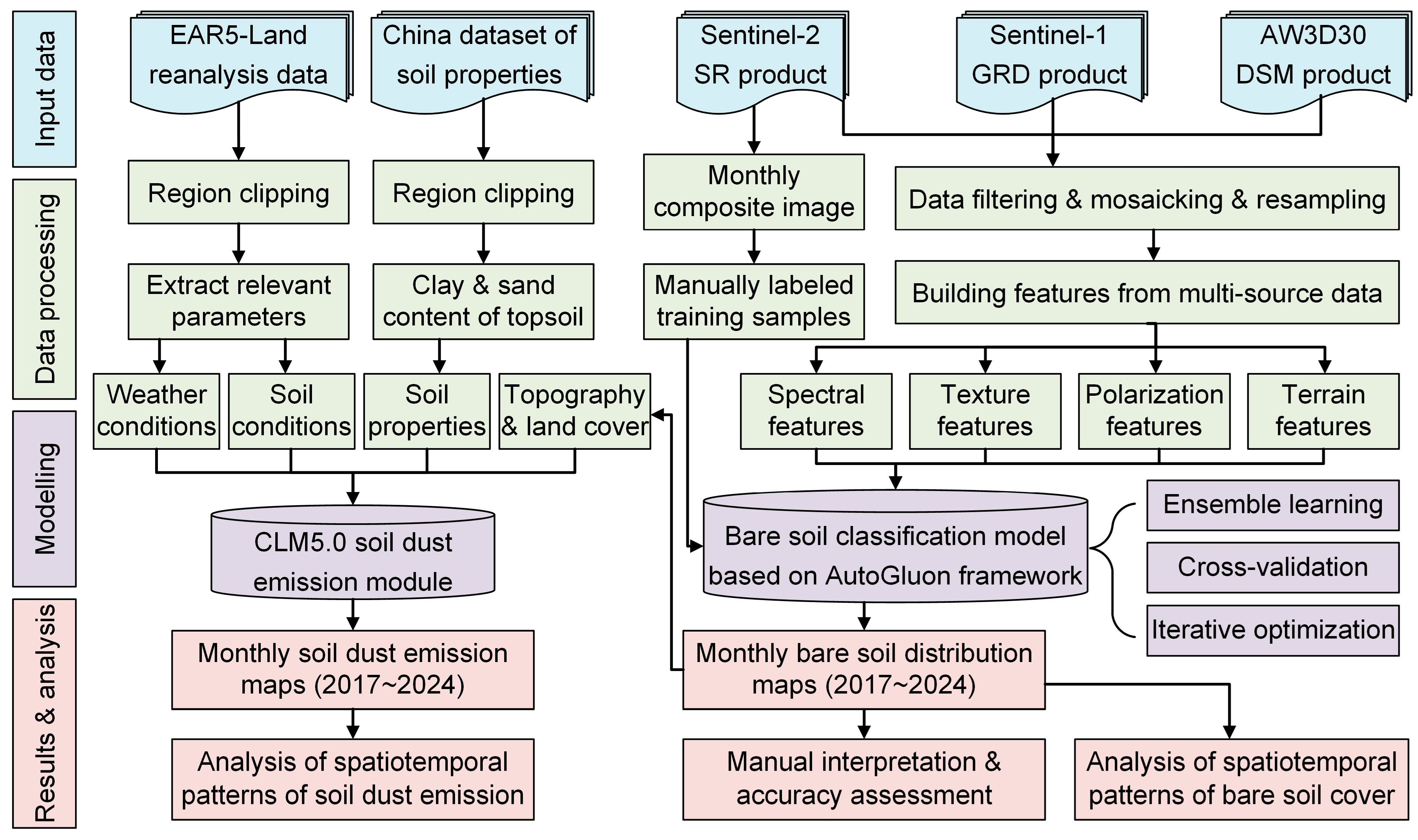
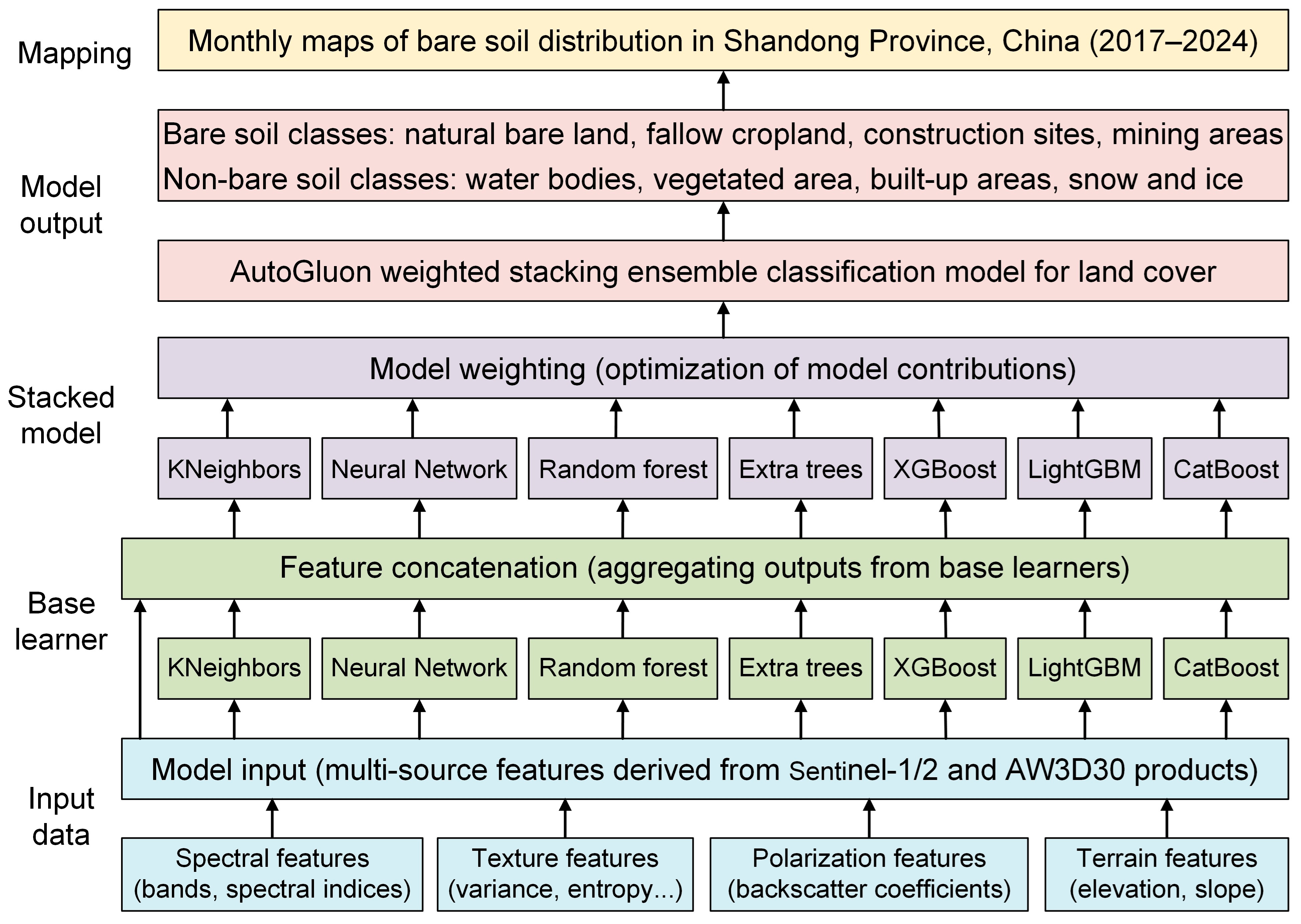

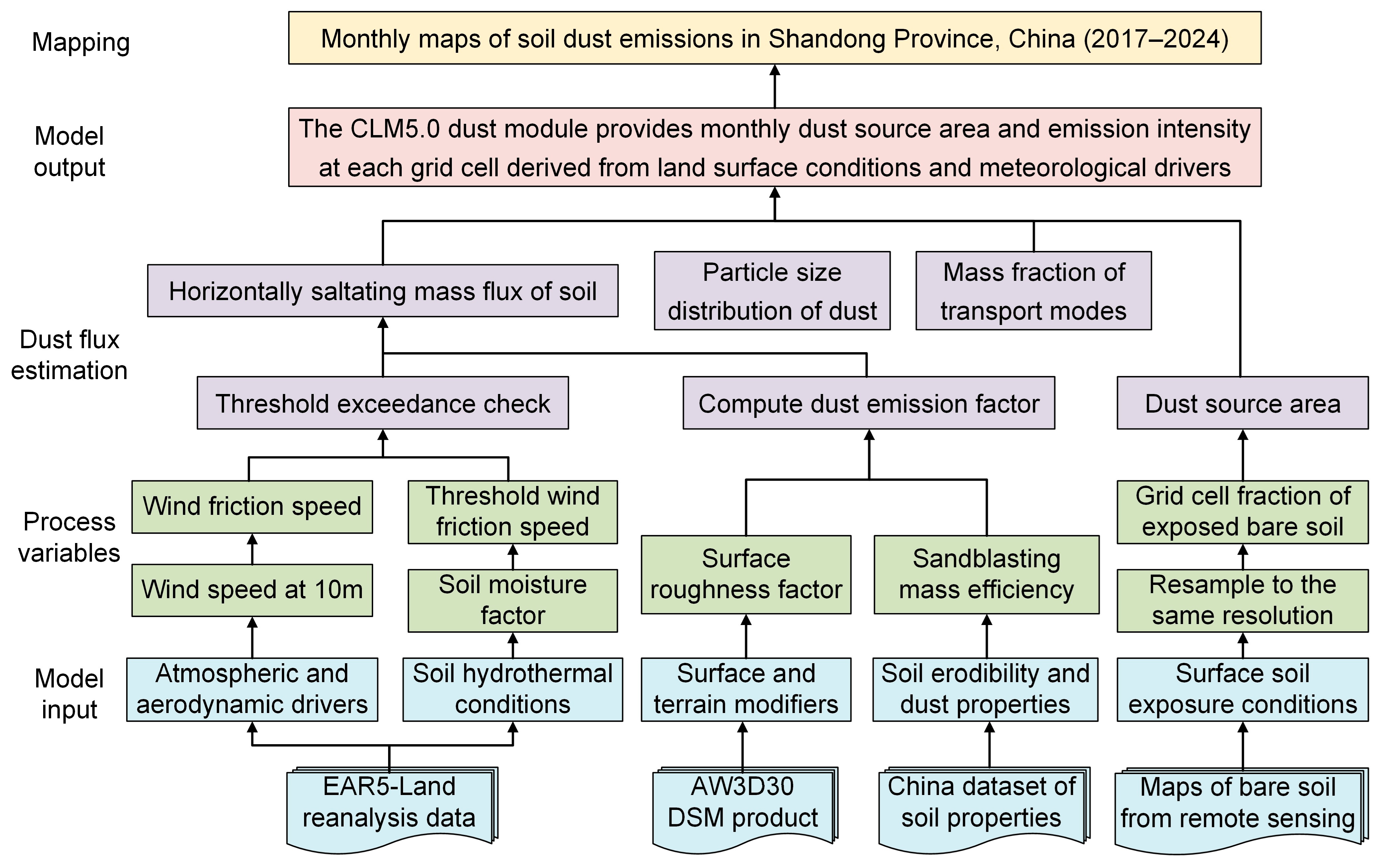
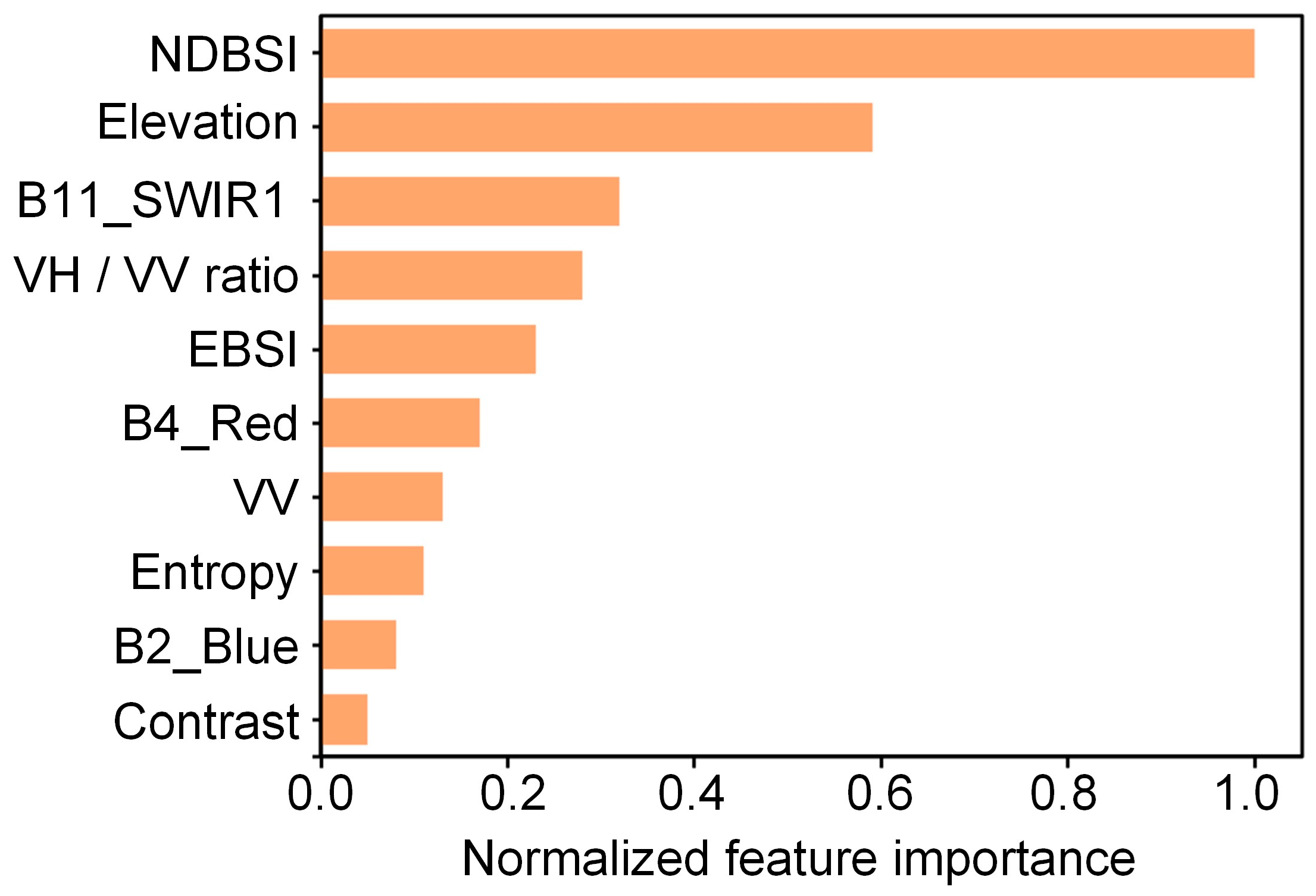
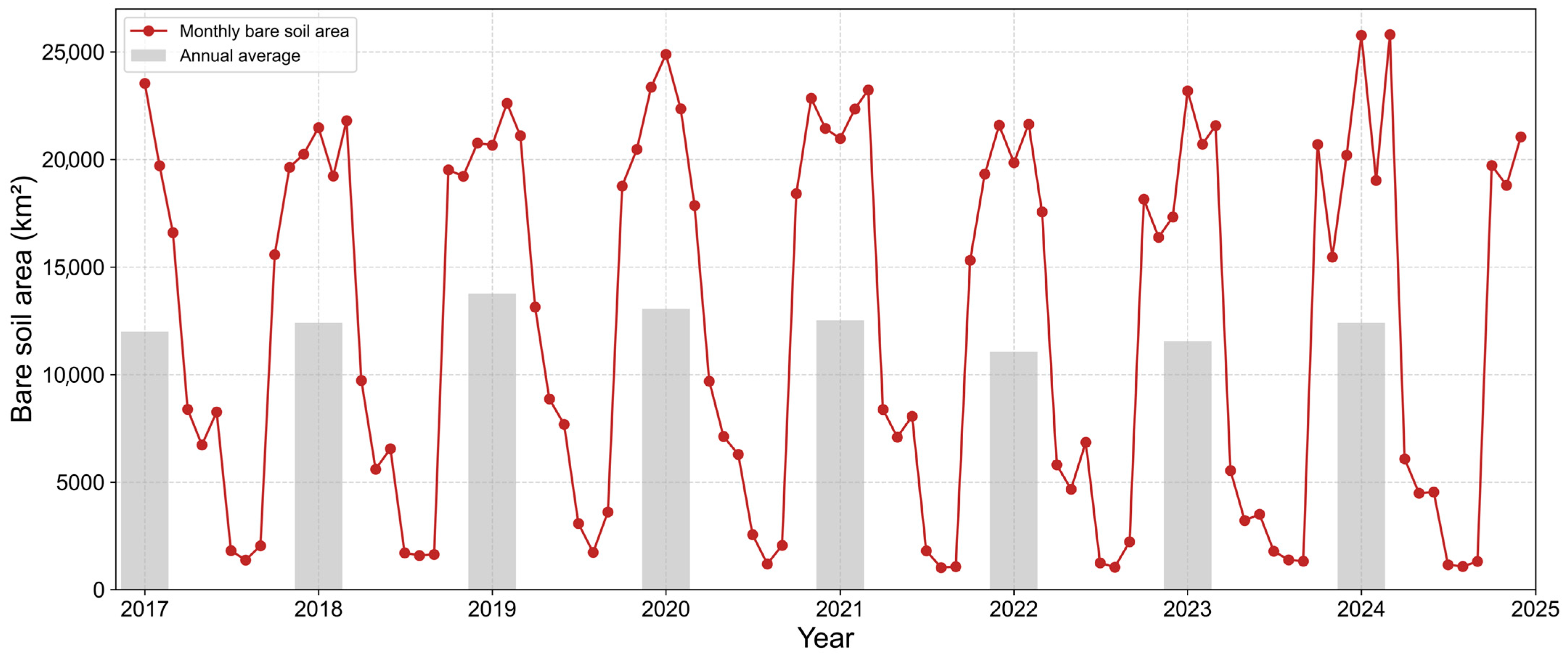



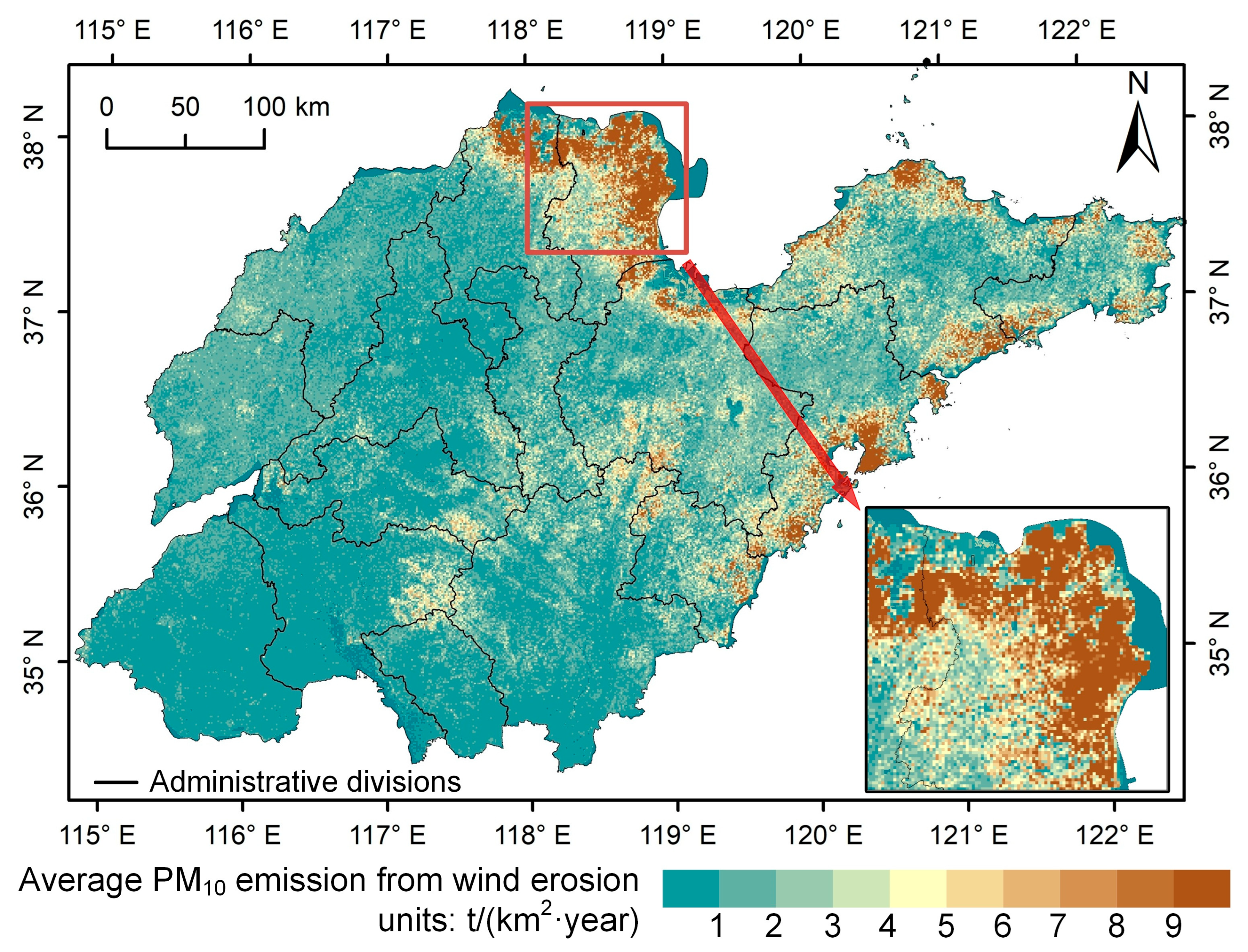
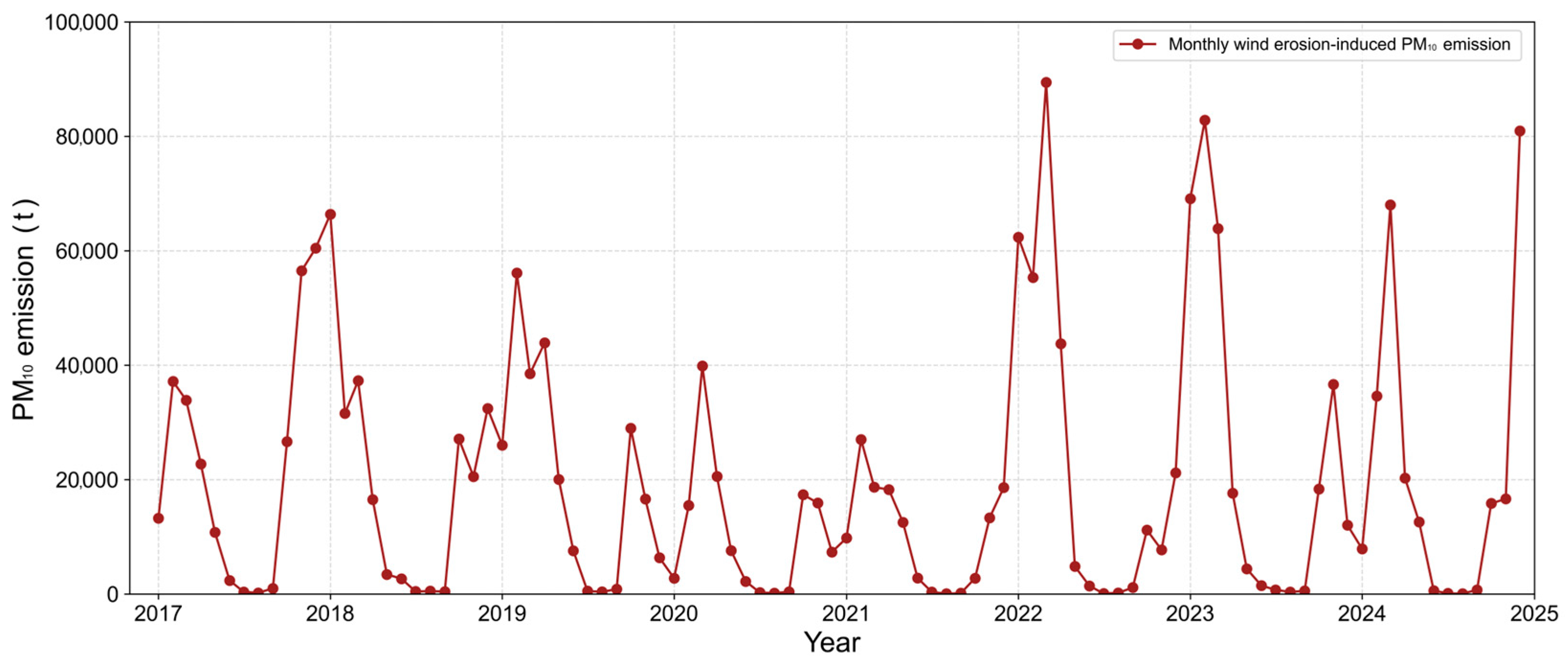
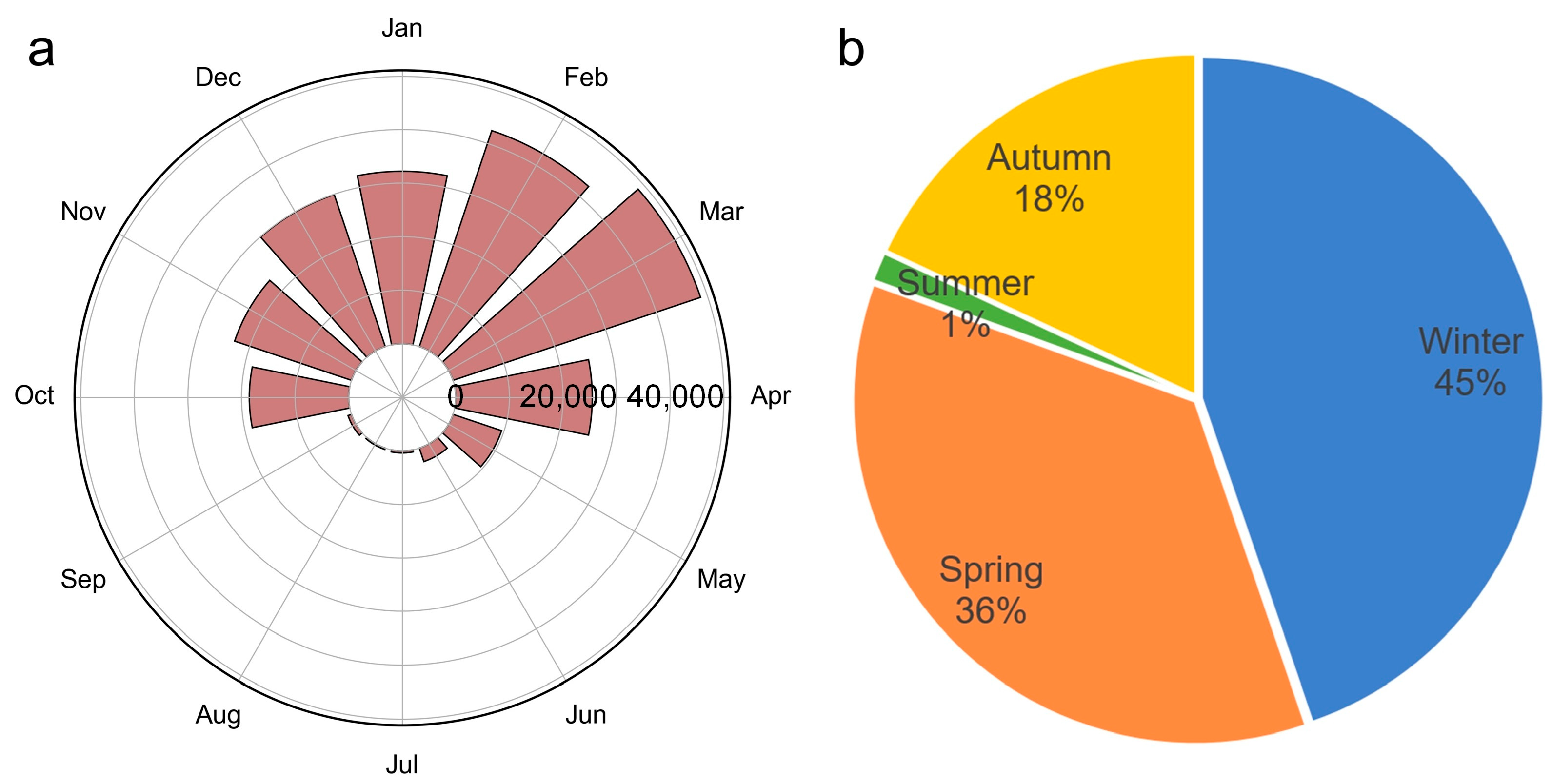
| Models | OA | Kappa | Precision | Recall | F1-Score |
|---|---|---|---|---|---|
| AutoGluon stacking ensemble | 0.93 | 0.86 | 0.94 | 0.92 | 0.93 |
| CatBoost | 0.92 | 0.85 | 0.93 | 0.92 | 0.92 |
| XGBoost | 0.92 | 0.84 | 0.93 | 0.91 | 0.92 |
| LightGBM | 0.91 | 0.83 | 0.93 | 0.89 | 0.91 |
| Neural networks | 0.90 | 0.79 | 0.92 | 0.87 | 0.89 |
| Extremely randomized trees | 0.90 | 0.79 | 0.91 | 0.88 | 0.89 |
| Random forests | 0.89 | 0.78 | 0.91 | 0.86 | 0.89 |
| K-nearest neighbors | 0.81 | 0.62 | 0.82 | 0.79 | 0.81 |
Disclaimer/Publisher’s Note: The statements, opinions and data contained in all publications are solely those of the individual author(s) and contributor(s) and not of MDPI and/or the editor(s). MDPI and/or the editor(s) disclaim responsibility for any injury to people or property resulting from any ideas, methods, instructions or products referred to in the content. |
© 2025 by the authors. Licensee MDPI, Basel, Switzerland. This article is an open access article distributed under the terms and conditions of the Creative Commons Attribution (CC BY) license (https://creativecommons.org/licenses/by/4.0/).
Share and Cite
Liu, A.; Chen, Y. Integrating Sentinel-1/2 Imagery and Climate Reanalysis for Monthly Bare Soil Mapping and Wind Erosion Modeling in Shandong Province, China. Remote Sens. 2025, 17, 3298. https://doi.org/10.3390/rs17193298
Liu A, Chen Y. Integrating Sentinel-1/2 Imagery and Climate Reanalysis for Monthly Bare Soil Mapping and Wind Erosion Modeling in Shandong Province, China. Remote Sensing. 2025; 17(19):3298. https://doi.org/10.3390/rs17193298
Chicago/Turabian StyleLiu, Aobo, and Yating Chen. 2025. "Integrating Sentinel-1/2 Imagery and Climate Reanalysis for Monthly Bare Soil Mapping and Wind Erosion Modeling in Shandong Province, China" Remote Sensing 17, no. 19: 3298. https://doi.org/10.3390/rs17193298
APA StyleLiu, A., & Chen, Y. (2025). Integrating Sentinel-1/2 Imagery and Climate Reanalysis for Monthly Bare Soil Mapping and Wind Erosion Modeling in Shandong Province, China. Remote Sensing, 17(19), 3298. https://doi.org/10.3390/rs17193298







